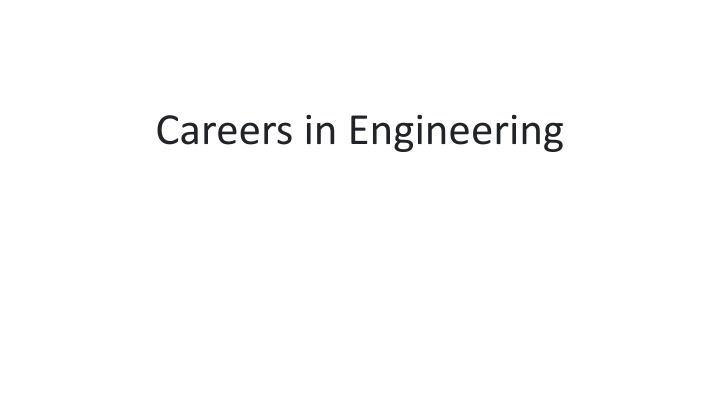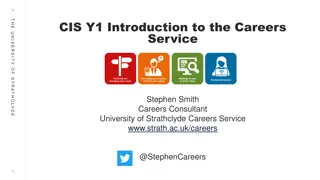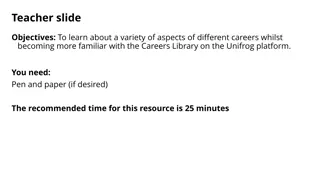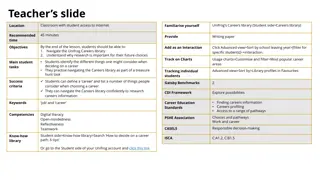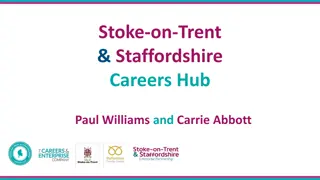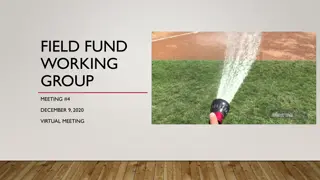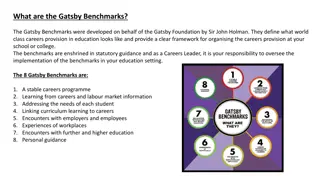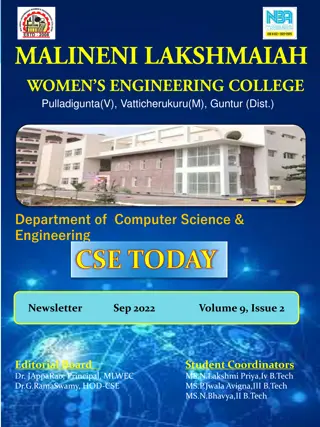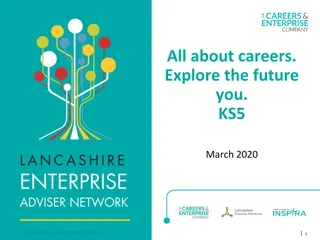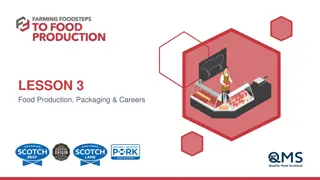Careers in Engineering: Insights into the Field Today
Explore the dynamic world of engineering careers, from the impact of technology to the best and worst aspects of the job. Discover the steps students can take to pursue a career in engineering, a typical day in the life of an engineer, and how classroom learning connects to this exciting field.
Download Presentation

Please find below an Image/Link to download the presentation.
The content on the website is provided AS IS for your information and personal use only. It may not be sold, licensed, or shared on other websites without obtaining consent from the author.If you encounter any issues during the download, it is possible that the publisher has removed the file from their server.
You are allowed to download the files provided on this website for personal or commercial use, subject to the condition that they are used lawfully. All files are the property of their respective owners.
The content on the website is provided AS IS for your information and personal use only. It may not be sold, licensed, or shared on other websites without obtaining consent from the author.
E N D
Presentation Transcript
Description Explore what it's like to have a job in the engineering field Connections to real world work that illustrates relevancy, and Why the engineering industry can be a great option for future careers. Key Questions 1. What is it like to be an engineer nowadays? 2. What are the best/worst parts of the job? 3. What steps do students need to take if they want to become an engineer of any kind? 4. What does a typical day look like? 5. How does what students are learning now connect to this career? Expected Outcomes 1. Discover some ins and outs of the field. 2. What they might do in a typical day 3. How to get started on this path 4. How this connects to current classroom content 5. Why they should consider this content for their futures.
What is it like to be an engineer nowadays? Technology is rapidly changing Affected by increasing automation Increasing use of software skills to do your job Overwhelming availability of information Online and digital involvement with fellow workers Continuously learning to keep up Increasing opportunities for changing jobs
What are the best/worst parts of the job? Pride in seeing your ideas come to life Being involved in something that is new and developing Technical and analytical work Being challenged to find solutions and fix problems Envisioning new and better ways to accomplish things Working on a team to achieve the same goals Failure of a product due to flawed thinking or planning Redoing work to fix problems
What steps do students need to take if they want to become an engineer of any kind? Become involved in STEM organizations and clubs Establish networks with like minded students/professionals Be on the lookout for internships Develop communication skills (reading, writing, speaking, and listening)
What does a typical day look like? Getting to work on time Meetings to update management on work progress Getting new assignments Resume work from where it was left the day before Performing calculations Calling suppliers to get information Developing work plans, and schedules Documenting work Reviewing the work of other engineers Lunch and relax Continue and Finish
How does what students are learning now connect to this career? STEM courses provide technical background Critical thinking skills - courses involving reflection and evaluation Communicating with others Understanding relationships between technology and people Teamwork skills in sports After class clubs
Engineering disciplines Aerospace Engineering Agricultural Engineering Architectural Engineering Bioengineering and Biomedical Engineering Biological Engineering Ceramic Engineering Chemical, Biochemical, Biomolecular Engineering Civil Engineering Communications Engineering Computer Engineering Computer Science Construction Engineering Construction Management Cybersecurity Cybersecurity Engineering Drafting and Design (General) Electrical and Electronics Engineering Engineering Management Engineering Mechanics Engineering, General Engineering Engineering Physics Environmental Engineering Environmental, Health, and Safety Facility Management Fire Protection Engineering Forest Engineering Geological Engineering Health Physics Industrial and Quality Management Industrial Engineering Industrial Hygiene Information Systems Manufacturing Engineering Materials Engineering Mechanical Engineering Metallurgical Engineering Mining Engineering Naval Architecture and Marine Engineering Nuclear and Radiological Engineering Ocean Engineering Optical Engineering Petroleum Engineering Safety Software Engineering Surveying and Geomatics Surveying and Geomatics Engineering Systems Engineering Telecommunications Engineering
Code of Ethics for Engineers Code of Ethics for Engineers 1. Hold paramount the safety, health, and welfare of the public. 2. Perform services only in areas of their competence. 3. Issue public statements only in an objective and truthful manner. 4. Act for each employer or client as faithful agents or trustees. 5. Avoid deceptive acts. 6. Conduct themselves honorably, responsibly, ethically, and lawfully so as to enhance the honor, reputation, and usefulness of the profession.
Area:Florida Period:May 2021 Occupation (SOC code) Aerospace Engineers(172011) Civil Engineers(172051) Computer Hardware Engineers(172061) Electrical Engineers(172071) Environmental Engineers(172081) Industrial Engineers(172112) Materials Engineers(172131) Mechanical Engineers(172141) Nuclear Engineers(172161) Hourly 10th percentile wage Hourly 25th percentile wage Employment per 1,000 jobs Annual mean wage(2) Hourly mean wage $107,070 $51.48 $30.85 $38.22 0.539 $94,050 $45.22 $23.54 $29.89 1.848 $114,720 $55.16 $36.37 $46.00 0.378 $94,270 $45.32 $29.17 $30.52 0.791 $89,540 $43.05 $23.27 $30.33 0.175 $93,320 $44.86 $28.96 $36.17 1.186 $92,360 $44.41 $23.49 $23.49 0.123 $90,060 $43.30 $24.61 $30.23 0.878 $111,420 $53.57 $37.28 $48.35 0.012 (2)Annual wages have been calculated by multiplying the corresponding hourly wage by 2,080 hours. SOC code: Standard Occupational Classification code -- see http://www.bls.gov/soc/home.htm Date extracted on :Aug 11, 2022
Principle of cathode ray tube (CRT) screen Principle of cathode ray tube (CRT) screen Source: Cathode-ray tube - Wikipedia
Development of TV screen Development of TV screen 1927 TV invented 1930 s Screens with 3 - 8 curved Cathode Ray Tube (CRTs) available 1964 Flat plasma screen invented at the University of Illinois 1997 Flat plasma screen measured 42 & sold for $15,000 1998 CRT screens reach 42 2006 LCD technology becomes competitive with plasma screens. 2009 LCD flat screens dominate the TV market Biography of Philo Farnsworth, American Inventor (thoughtco.com)
